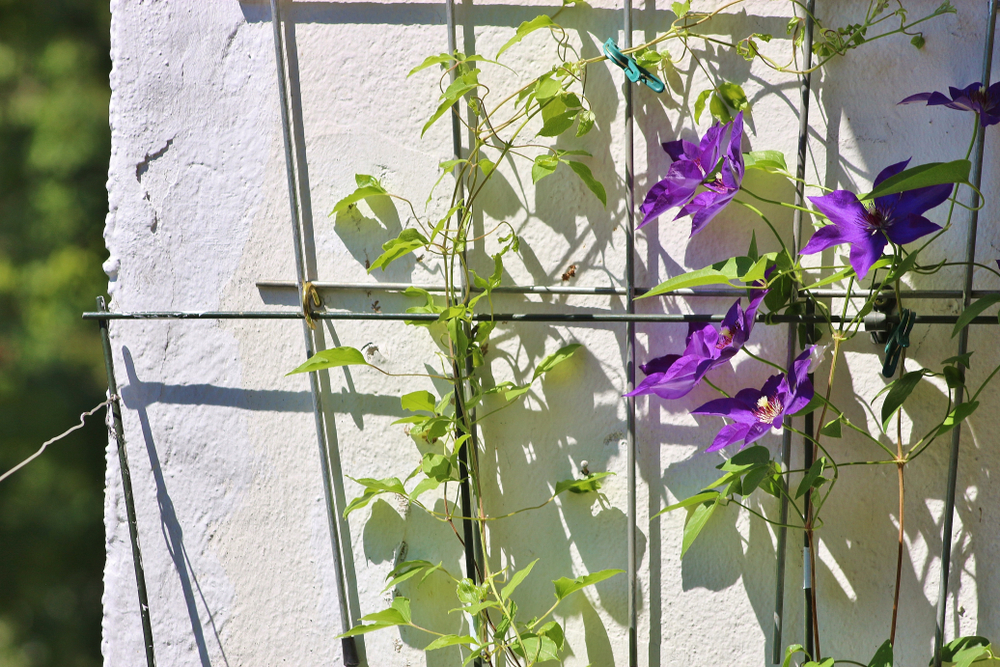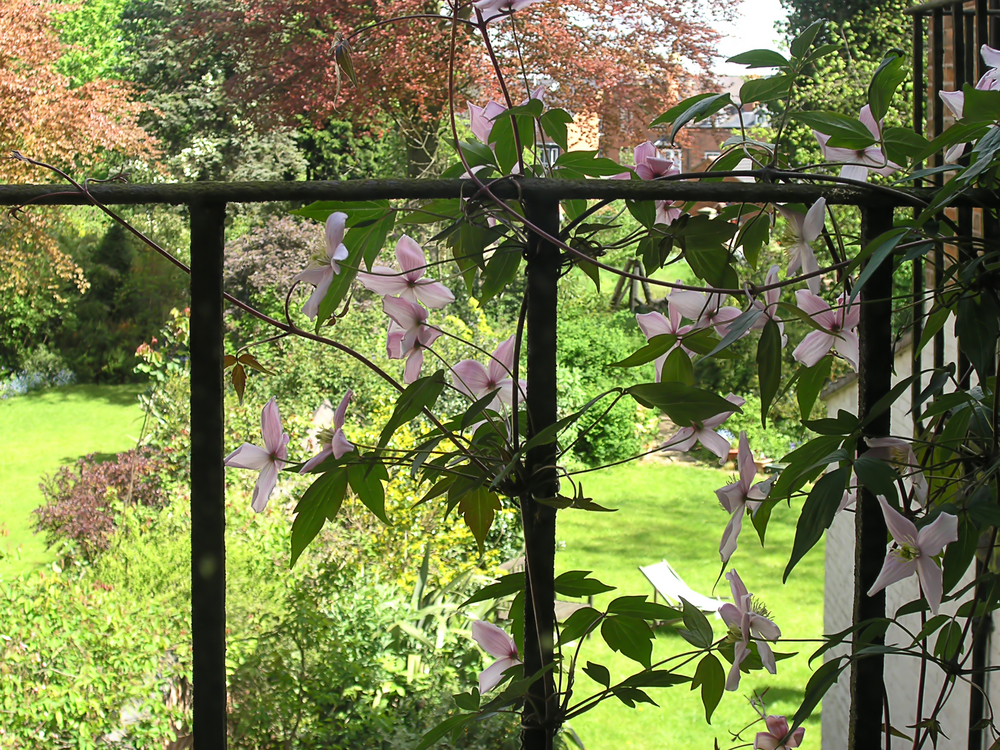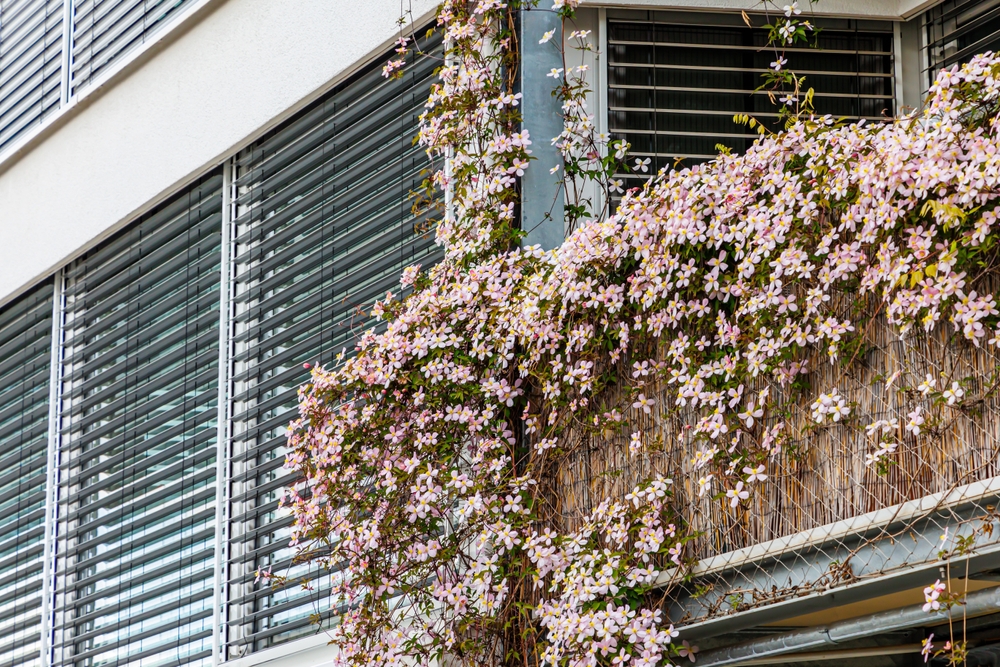Clematis is a fairly easy plant to grow. If given the right conditions, it’ll produce prolific blooms all season long and, helpfully, requires very little maintenance. This makes clematis a great option for beginner gardeners or those who don’t want to spend much time trimming their plants.
Below, we’ll cover a complete guide for how to grow clematis on a balcony or deck. While it’s an easygoing plant, it still helps to know the best way to grow it.
What to Know Before Getting Started
Clematis is a genus of nearly 400 species of plant. It’s not worth getting into the specifics of all the different kinds because some are very similar. Instead, some key points include:
- All clematis are creeping vines, and the stems become woody as they age.
- Clematis can flower in any season, although summer is most common. Some flower twice a year.
- There are numerous flower colors available, including purple, pink, white, red, and bi-color combinations.
- Not all clematis flowers smell. Many do, though, and can range from sweet almonds and vanilla to orange and musk. Generally, it’ll say on the plant’s label whether it has aromatic flowers.
Your main buying criteria should be the color of flowers you want and the aroma. Once you’ve got these narrowed down, you should be able to choose a species quite easily.
Other than this, some important considerations before growing clematis include:
Climate/Sun Exposure
Clematis are native to the northern hemisphere. As such, they don’t like it super hot, but we’re talking tropical climates. Generally, USDA Zones 4-9 are best.
These plants prefer partial to full sun. However, you can find species that suit any level of sun exposure if you’re willing to do some research. Pretty much all species prefer being kept out of particularly windy conditions, though.
Growth Habit
As mentioned, clematis are climbing/vining plants. The stems become woody as they age, but are quite fragile until they’re several years old. You’ll need to provide them with plenty of support until they reach this stage.
Along with tying the vines up, clematis will need something to grow up, which can include:
- Deck railing
- Balcony wall or railing
- Wood or wire trellis
Objectively, a metal balcony or deck railing will be better than a wood one. This is because mature plants can be pretty heavy, and wood railings might not handle the strain as well. However, it’ll be fine as long as you keep the plant well pruned or provide plenty of extra support.
Clematis don’t have suckers like some vining plants. You’ll need to tie the vines up or hold them in place with hooks. Provided you do so, you could grow a clematis up pretty much any surface. Adhesive hooks (like these) would be useful for supporting clematis vines up a wall or glass railing pane.
Planters
Unsurprisingly, growing a clematis on a balcony will mean using a planter. If you’re growing a clematis on your deck, it’d be best to place it in the ground if possible and grow it up to your deck. While it’ll take longer, the plant will get much bigger in the end.
For healthy plants, don’t choose a planter smaller than 18” in diameter (like this one). You’ll want the largest container you can justify having on your balcony otherwise the plant’s roots will eventually get cramped.
Ideally, choose a terracotta pot, particularly in warmer climates. Plastic is fine but it can get too hot in the summer. If terracotta isn’t an option, choose light-colored plastic planters.
Ensure the pot has large drainage holes because clematis don’t like sitting in water. If you have heavy rainfall in your area, go a step further by putting the container on bricks to elevate it.
You’ll want to avoid using railing planters for a clematis because they’re not big enough and the plant will be too heavy. Stick with a sturdy floor planter for best results.
Balcony vs. Garden Growing
The main difference between growing a clematis on a balcony and in a garden is the space the roots will have. It’s not a massive issue to grow a clematis in a pot, but large varieties will never get as big as they will when planted directly in the ground.
Pruning
Clematis are really easy to prune. Focus on damaged or weak-looking stems for a strong and healthy plant. You’ll need to prune it once a year after its flowering season, but any time before spring is fine for plants that flower from spring onwards.
Watering
Clematis need heavy watering but don’t like to sit in water. Make sure the water runs out the pot, and water before the soil is completely dry. Stick your finger an inch or two into the soil. If it’s dry, it’s time to water.
How to Grow Clematis on a Balcony or Deck
There are 2 main ways to grow clematis on a balcony or deck. The first is as a self-contained plant grown up a trellis. The second is as a semi-wild mass growing up the railing. Although they follow fairly similar guides, we’ll cover both below.
Method 1: Growing Clematis Up a Trellis

To grow a clematis up a trellis in its pot, you’ll want to go with a dwarf variety. These are smaller than normal clematis, meaning they don’t develop as extensive root systems. Some options include:
- Sieboldii
- Polish Spirit
- Josephine
- Viticellas
- Arctic Queen
Other than the clematis itself, you’ll need:
- A planter (such as this)
- Soil (such as this)
- A trellis (such as this or this)
Alternatively, you can make your own trellis out of bamboo canes and fishing wire or gardener’s wire. Arrange the canes in a teepee shape and then wrap circles of wire around them to give the clematis plenty of spots to hold on to.
The steps are as follows:
1. Soak the clematis in water for 20-30 minutes before removing from its nursery pot. This just helps to loosen the root ball and soil.
2. While that’s happening, put some broken pot or stones in the bottom of your planter and sprinkle over a layer of soil.
3. Remove the plant from its nursery pot and tease out its roots before you place in the planter.
4. Backfill with soil, compacting as you go.
5. Insert the trellis into the pot, or secure to a wall where you’ll sit the pot.
6. If your clematis is fixed to a bamboo cane in its nursery pot, remove it now.
7. Without being too rough, guide any existing vines towards the trellis and secure if you can.
8. Wait a few days and then begin watering as normal.
Dwarf varieties will still take a few years to mature, although they should reach their full height by year 2. Your plant will be healthiest if you prune it properly and only allow the strongest stems to mature.
Method 2: Growing Clematis Up a Railing

This method is almost identical in terms of soaking and planting out the clematis. However, you can choose pretty much any species if you’ve got enough room for the larger varieties.
Some good options for balconies include:
- Alba
- Abundance
- Arabella
- Black Prince
- Twinkle
- Valor
All these varieties do well in windy conditions, making them suitable for balconies and decks.
For growing up a railing, you’ll want the biggest planter you can find. A rectangular one (like this) will be more space efficient on a balcony than a circular one.
Larger plants will take a bit longer to mature, but you can expect vigorous flowering after 3 years. Prune the plant quite heavily in the first few seasons, cutting back to around 10” above the soil if the growth doesn’t look healthy.
You can support tendrils by fixing them to railings with gardener’s twine. You’ll only need to do this for a few years because the plant will take care of itself after then.
Shortcuts to Established Plants
Unfortunately, there’s not much you can do to speed up clematis maturation. They can grow pretty fast but need a few years to properly establish their roots. The best thing you can do is buy a healthy plant that’s at least 2 years old, which you can spot by its woody base stems.
Final Thoughts
A well-established clematis is a great way to add color to a balcony or deck. Luckily, it’s an easy plant to grow in pretty much all situations. Follow the steps above and you’ll have a happy and healthy clematis ready to provide you with months of beautiful flowers.
